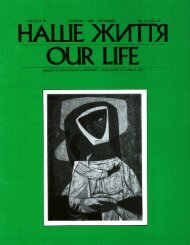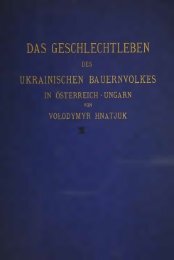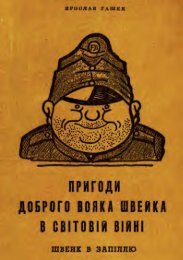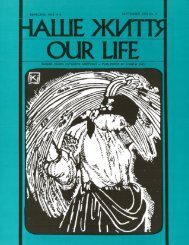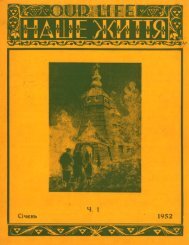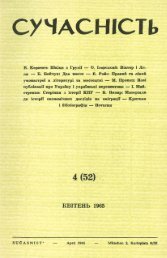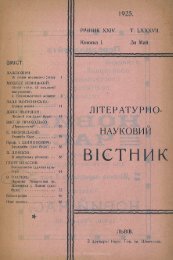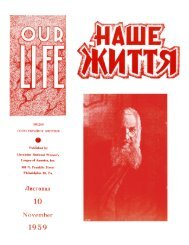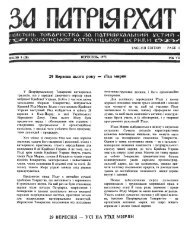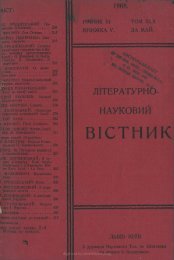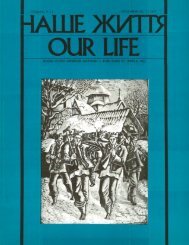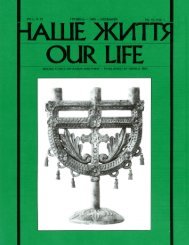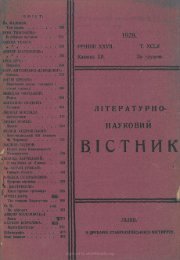ÐаÑе ÐиÑÑÑ (Our Life), ÑÑк 1981, ÑиÑло 7, липенÑ-ÑеÑпенÑ
ÐаÑе ÐиÑÑÑ (Our Life), ÑÑк 1981, ÑиÑло 7, липенÑ-ÑеÑпенÑ
ÐаÑе ÐиÑÑÑ (Our Life), ÑÑк 1981, ÑиÑло 7, липенÑ-ÑеÑпенÑ
You also want an ePaper? Increase the reach of your titles
YUMPU automatically turns print PDFs into web optimized ePapers that Google loves.
SO YOU WANT TO PAINT<br />
With the post-war affluence there came an intensified interest<br />
in art, and artists found a ready market for their work. Art<br />
schools developed as the neo-artists sought guidance in their<br />
talents. The artists no longer needed to "starve for art" as in the<br />
years past, as he could readily substain himself in commercial<br />
fields or research and in the spare time develop his own creative<br />
efforts. The art centers organized their own art exhibits and<br />
found a ready marked for their labors. Who said a good painting<br />
must be produced by a ’’name"<br />
There are various types of art education — art schools,<br />
studio workshops, travel workshops and correspondence<br />
schools. Demonstrations and art books are of great help. There<br />
are many opportunities for a career in art today — fine arts,<br />
teaching or commercial art. An art school provides the<br />
maximum amount of time. Most art schools are concentrated in<br />
and around large metropolitan areas, where practicing artists<br />
teach. The larger the school, the broader the range of art<br />
courses.<br />
In a studio workshop, one meets artists of varied<br />
experience. Instruction and guidance are given at a more individual<br />
basis.Often a professional artist attends to benefit from<br />
the stimulating experience of being with other painters, which<br />
is beneficial to creativity. A model is provided for a nominal fee,<br />
and the artist can benefit sketching from a live model at<br />
reduced rates, just as an opera star exercises her scales. The<br />
art student works at his own rate of speed, getting instruction,<br />
guidance and criticism in all stages from start to finish. This is<br />
not always possible in a classroom.<br />
Wokshop students are serious art students, whether part<br />
time or full time. Everyone is there because he wants to be<br />
there for various purposes. Age does not exist in the workshop<br />
because art is universal and everyone speaks the same<br />
language. When a creative person finds his outlet of self expression,<br />
all other matters go down the drain. A fever of excitement<br />
envelopes him and all else takes a back seat in his life.<br />
Some sing, play a musical instrument or write. Some join dramatic<br />
groups and involve themselves in the drama of life. An<br />
artist who paints does so at every opportunity, even without a<br />
palette. As he walksalongthe street, or rides in a car, the artist<br />
squints at the flowers or buildings, finding shadows and highlights.<br />
Sitting under a tree he will mentally mix the colors of the<br />
sky, or the dark and light colors of the landscape. He is<br />
constantly seeing and painting mentally. An artist sees much<br />
more than others. One can say that an artist is never lonely.<br />
Each artist sees differently, and has his own individual way<br />
of expressing what he sees. It is often said that six different<br />
artists may paint the same landscape or portrait, but get six<br />
different versions of what they see. Each painting is as individual<br />
as a handwritten signature.<br />
Deep satisfaction comes from painting, but one must have<br />
time to devote the countless hours one must practice, first<br />
drawing, then the variety of exercises in painting. Always there<br />
will be new and intriguing avenues, and as the painter proceeds<br />
in his artistic attempts in trial and error he starts looking for a<br />
teacher of substantial reputation to guide him in the principles<br />
of painting. But another problem comes along, as each<br />
theacher has his own principles which he feels make "good<br />
art.” Many use a limited palete, and the neo-artist finds his<br />
paints drying away in a box, as he buries himself in the<br />
mysteries of mixing six to nine colors into sixty other colors.<br />
by MARY ROHOW SKY<br />
You not only mix colors, but you learn why you are doing<br />
it. Three dimensions must be forced through color and<br />
perspective. Much color can be found everywhere. Color is a<br />
very personal matter. Black and white are not considered colors<br />
and are only encouraged to be used mixed. Grey in its many<br />
different tints can be a very beautiful color, and one can be very<br />
happy painting in just the three colors — Prussian Blue, Raw<br />
Sienna and White.<br />
Dogged tenaciousness follows. The artist student meets<br />
artists who are not well known for their artistic abilities, but<br />
who are excellent teachers, and artists who are excellent<br />
painters but poor teachers. One well known artist writes<br />
excellent books on painting, but his students leave his class<br />
room empty and frustrated — he cannot communicate with<br />
them. Money pours as the artist student buys books and<br />
materials to aid him in his ultimate goal, and the more he<br />
studies the more the student realizes that even great artists do<br />
not always produce excellent paintings each and every time.<br />
And so the search for great painting goes on and on, tackling<br />
the almost impossible, with no room for the fainthearted, and<br />
each study a proving ground, not a finished picture. Discipline<br />
becomes a form of habit and as long as a high standard is set,<br />
progress is made. Composition and values are all important to a<br />
good painting. Center of interest and mass simplicity are more<br />
important than color. Color may fade but the original composition<br />
remains. Good color does not just happen, it has to be<br />
discovered, as with experience and practice the artist begins to<br />
"see" and becomes aware of all colors about him, even in<br />
shadows.<br />
Tim e and practice will develop your progress in art until<br />
you can paint without the self consciousness that can mar the<br />
most beautiful efforts. Much emotion goes into the painting but<br />
the artist must exhibit his work to get the reaction of the public<br />
— do they feel what he feeels. They say artists are long lived. I<br />
believe this to be true — each and every one has so much<br />
planning for the next painting — and the next — and the next,<br />
they have no time to die.<br />
REPORT ON THE MAYOR’S CONFE<br />
RENCE ON IMMIGRATION — MAY 5,<br />
<strong>1981</strong> BOARD OF ESTIMATE CHAMBER<br />
— CITY HALL<br />
There were approximately 80 ethnic groups represented at<br />
what proved to be a most interesting seminar. Representing the<br />
Regional Council of the UNWLA were the following ladies —<br />
Oksana Szczur, Lydia Magun, Rosalie Polche, and Anastasia<br />
Brodin.<br />
There were numerous speeeches, a panel discussion in the<br />
morning and then again in the afternoon with time allotted for<br />
questions and answers, and all relating to immigrations past,<br />
present and future.<br />
Immediately prior to breaking for lunch, Rosalie Polche<br />
created a sensation when she took to the podium and after giving<br />
a very informative resume on Ukrainians and their history,<br />
inquired as to why we were not asked to participate in the panel<br />
discussion and why, when the various ethnic groups were<br />
mentioned, Ukrainians were completely ignored. One of the<br />
Cont. p. 27<br />
НАШЕ ЖИТТЯ”, ЛИПЕНЬ-СЕРПЕНЬ <strong>1981</strong> 23




